Written by Nancy Miorelli
We have to get something out of the way first. A lot of people use the word “poisonous” to mean “It hurt me more than just a bite and I could probably die”.
However, “Poisonous” and “Venomous” have very specific definitions which is summed up perfectly in this comic by Snake Buddies. However, you should read their full explanation as I can’t spend much time on it.

Lots of bugs are poisonous, but you probably don’t go around eating bugs.
PC: Snake Buddies
So before you ask if something is poisonous, ask yourself
1) Did I try and eat it and die?
2) Did it try and eat me and I died?”
I’m having a guess that you probably don’t go running around popping bugs in your mouth like skittles, so I’m mainly going to talk about venomous insects that are more likely to hurt you, specifically.
That being said, here in the US we’re lucky because we don’t have too many serious bugs or other arthropods that can kill you, unless you’re an unlucky individual with severe allergies.
Packing a Punch is Expensive
Let’s get one thing out of the way. Say you’re going to make an organism and you have $100 dollars to buy legs, mouth parts, eyeballs, and anything else you want to build your critter. Parts are expensive, and there are certain things that you need to make your animal work. Like a heart and a stomach, which would be equivalent to putting an engine in a car.

You can play this game here.
PC: Just Kids Games
But then after you get through the basic stuff you have a little bit of cash left to spend on the nice things. You could pay a little more to beef up your sensors – making better eyeballs, or better noses. You can add more muscle for running quickly. But some animals dump all their extra cash on venom or other toxic chemicals.
To continue the car analogy, it would be like if you bought a car, put an engine in it, and then installed flamethrowers on the side for “added protection” and “security.”
So the moral of this story is that venom and other toxins are expensive. You can even see this in animal behavior. Scorpions inject pre-venom into animals they know they don’t want to eat – just to scare away. Rattlesnakes rattle to scare animals off, even though they have venom.
Stay Away – Seriously
Because the poison or venom is expensive, many animals – including insects – tell you that they pack a punch. This is called “Warning Coloration”. These animals don’t want to waste their expensive chemicals if they don’t have to.

Left: Lubbers produce a frothy foam from it’s thorax when it’s disturbed. It smells bad and tastes bad.
Right: Yellow jackets pack a powerful sting.
And it’s not just true for grasshoppers and wasps – lots of things have warning coloration. If you want to know to stay away from something, bright colors like red, orange, and yellow – especially with black, tell you to stay away.

Left: The Monarch butterfly has toxins from the milkweed plant that its caterpillar eats.
Right: Black widow spiders are most easily recognized by their red hourglass markings. They’re one of the most dangerous spiders in the US.
Strength in Numbers
Warning coloration is effective. We can easily recognize wasps and bees. We know not to touch them because they can hurt us. Wasps and bees are all easy to recognize because of their bright colors. Yellow and black tells us “back off.” These insects mimic each other. When toxic or harmful animals look like other toxic and harmful animals, it’s called “Müllerian Mimicry“.
This mimicry works because it continues to enforce the lesson, “Brightly colored things can hurt you. Seriously, don’t touch.”
Heliconius butterflies are classic mullerian mimics. They’re all poisonous to birds.
PC: Repeating Patterns of Mimicry. Meyer A, PLoS Biology CC by 2.5
There’s Always Cheaters
This system works so well that there are a lot of cheaters. Flies are probably the best example of this as there are so many that mimic wasps and bees.

These are all flies. They range from really good mimics to just average. But if you saw any of these zip past you, you probably wouldn’t reach out and grab any of them because of the colors.
PC: Alvesgaspar (CC by SA 3.0)
Okay Sooo, What Can I Touch?
Spiders, scorpions, centipedes, wasps, ants, and bees are the ones that are the most likely to hurt you or do damage. This is because they’ll inject venom into you that will really hurt. A lot of true bugs are brightly colored but are mainly poisonous to animals that would eat them. That being said, they can still bite, as anything with a mouth can bite you.
The most important thing is that if you don’t know if it’s dangerous, you just shouldn’t touch it.

I’m the Large Milkweed Bug. I’m poisonous so don’t eat me. I can still bite, so handle me with care.
PC: Lucy Mills (CC by NC ND 2.0)



Pingback: A Bug Landed On Me. Now What? | Ask an Entomologist
Pingback: On Tuesday we will… – Site Title